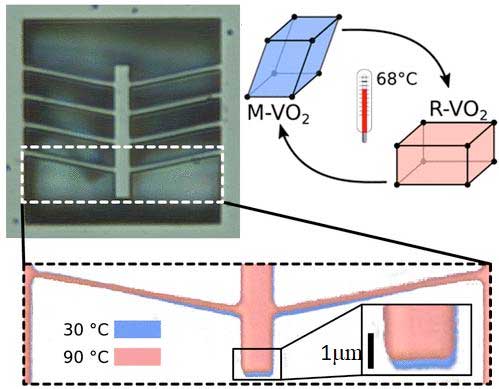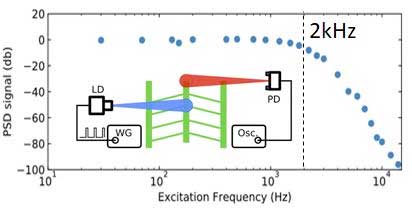| Sep 15, 2020 | |
New on/off functionality for fast, sensitive, ultra-small technologies(Nanowerk News) How do you turn on and off an ultra-small component in advanced technologies? You need an actuator, a device that transmits an input such as electricity into physical motion. However, actuators in small-scale technologies to date have critical limitations. |
|
| For example, if it's difficult to integrate the actuator into semiconductor electronics, real-world applications of the technology will be limited. An actuator design that operates quickly, has precise on/off control, and is compatible with modern electronics would be immensely useful. | |
| In a study recently published in Nano Letters ("Planar nanoactuators based on VO2 phase transition"), a team including researchers from Osaka University has developed such an actuator. Its sensitivity, fast on/off response, and nanometer-scale precision are unparalleled. | |
 |
|
| Bright-field microscopy image of a VO2 chevron-type planar actuator. Superposition in false color of the tip of the shuttle at low and high temperature. (Image: Osaka University) | |
| The researchers' actuator is based on vanadium oxide crystals. Many current technologies use a property of vanadium oxide known as the phase transition to cause out-of-plane bending motions within small-scale devices. For example, such actuators are useful in ultra-small mirrors. Using the phase transition to cause in-plane bending is far more difficult, but would be useful, for example, in ultra-small grippers in medicine. | |
| "At 68°C, vanadium oxide undergoes a sharp monoclinic to rutile phase transition that's useful in microscale technologies," explains co-author Teruo Kanki. "We used a chevron-type (sawtooth) device geometry to amplify in-plane bending of the crystal, and open up new applications." | |
| Using a two-step protocol, the researchers fabricated a fifteen-micrometer-long vanadium oxide crystal attached by a series of ten-micrometer arms to a fixed frame. By means of a phase transition caused by a readily attainable stimulus--a 10 °C temperature change--the crystal moves 225 nanometers in-plane. The expansion behavior is highly reproducible, over thousands of cycles and several months. | |
 |
|
| Illustration of the experiment: A blue laser diode (LD), controlled by a waveform generator (WG), is focused in the middle of the shuttle while a red laser spot partially covers its tip. Reflected red light is collected by a photodiode (PD) and the resulting electrical signal is monitored by an oscilloscope (Osc) and the frequency response of the device under study. Cutoff frequency, ~2 kHz. The device is thermalized at 50°C during excitation with the blue laser. We acquired data points manually, and observed no appreciable drift over time, indicating reproducibility over thousands of cycles. (Image: Osaka University) | |
| "We also moved the actuator in-plane in response to a laser beam," says Nicola Manca and Luca Pelligrino, co-authors. "The on/off response time was a fraction of a millisecond near the phase transition temperature, with little change at other temperatures, which makes our actuators the most advanced in the world." | |
| Small-scale technologies such as advanced implanted drug delivery devices wouldn't work without the ability to rapidly turn them on and off. The underlying principle of the researchers' actuator--a reversible phase transition for on/off, in-plane motion--will dramatically expand the utility of many modern technologies. The researchers expect that the accuracy and speed of their actuator will be especially useful to micro-robotics. |
| Source: Osaka University | |
|
Subscribe to a free copy of one of our daily Nanowerk Newsletter Email Digests with a compilation of all of the day's news. |
